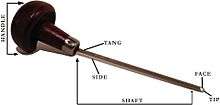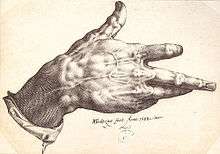Burin (engraving)

In engraving, a burin (/ˈbjuːrɪn/, from the French burin, also used for "cold chisels") is a steel cutting tool which is the essential tool of the form.
Design
The burin consists of a rounded handle shaped like a mushroom, and a tempered steel shaft, coming from the handle at an angle, and ending in a very sharp cutting face.
Burins typically have a square or lozenge shape face, though several other types are used. A tint burin consists of a square face with teeth, enabling the creation of many fine, closely spaced lines. A stipple tool allows for the creation of fine dots. A flat burin consists of a rectangular face, and is used for cutting away large portions of material at a time.
Uses

An engraving burin is used predominantly by intaglio engravers, but also by relief printmakers in making wood engravings. Its older English name, still often used, is graver. Usually an engraver will have several tools, of different sizes and shapes of cutting face.
In use, it is typically held at approximately a 30-degree angle to the surface. The index and middle finger typically guide the shaft, while the handle is cradled in the palm. Of note is the 16th-century Flemish engraver Hendrik Goltzius, whose malformed hand was ideally suited for the cradling and guiding of a burin.
References
- ↑ Alexia Rostow. "Porcuprints-Printmaking". Retrieved 2011-08-06.
External links
